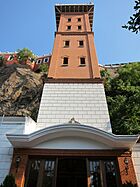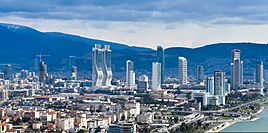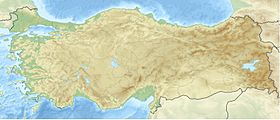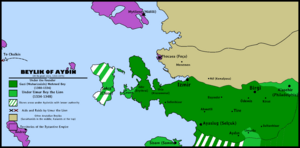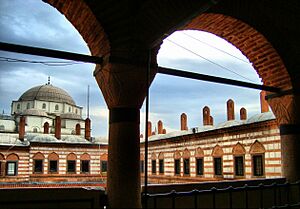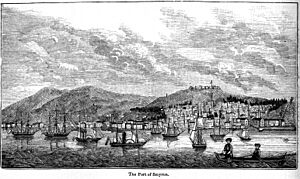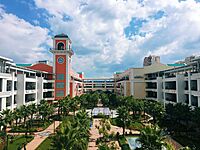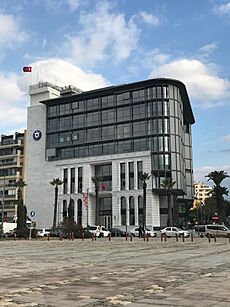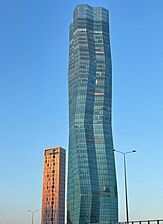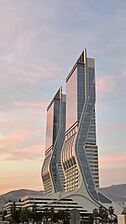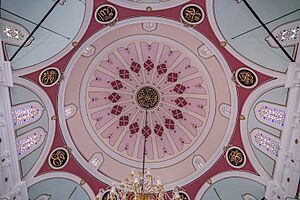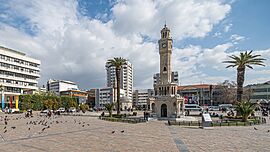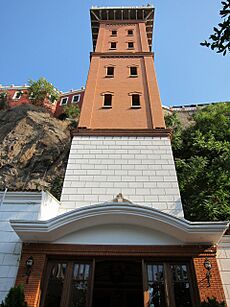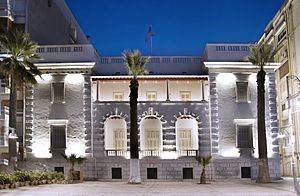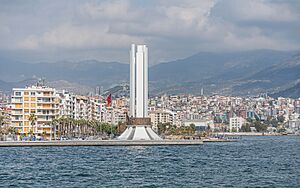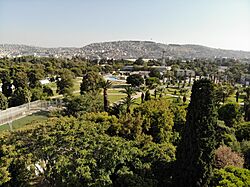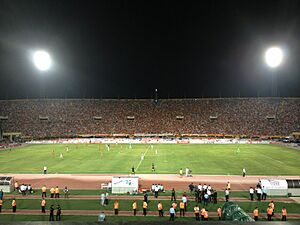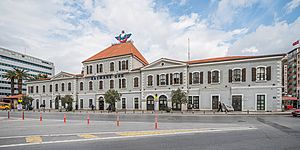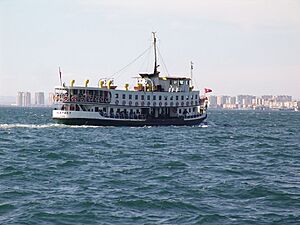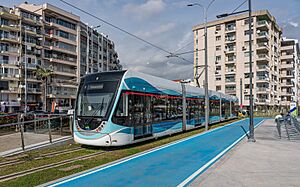İzmir facts for kids
Quick facts for kids
İzmir
|
|
|---|---|
|
City
|
|
|
Alsancak quarter in the Konak district
İzmir Clock Tower
Asansör
Konak Pier
Kültürpark
Skyscrapers in Bayraklı
|
|
| Nickname(s):
Pearl of the Aegean
(Turkish: Ege'nin İncisi) |
|
| Country | |
| Region | Aegean |
| Province | İzmir |
| Earliest known settlement | c. 6500 BC (Yeşilova Mound in Bornova district) |
| Founded | c. 11th century BC (as ancient Smyrna) |
| Capital town | Konak (de facto; Turkish metropolises have no official capital towns) |
| Area | |
| • City | 12,012 km2 (4,638 sq mi) |
| • Urban | 919 km2 (355 sq mi) |
| • Metro | 2,259 km2 (872 sq mi) |
| Elevation | 2 m (7 ft) |
| Population
(31/12/2019 estimation)
|
|
| • City | 4,367,251 |
| • Urban | 2,965,900 |
| • Urban density | 4,761/km2 (12,330/sq mi) |
| • Metro | 3,209,179 |
| • Metro density | 1,420.62/km2 (3,679.4/sq mi) |
| Demonym(s) | English: Izmirian Turkish: İzmirli |
| GDP | |
| • City | ₺ 462 billion US$ 51 billion (2021) |
| • Per capita | ₺ 104,791 US$ 11,668 (2021) |
| Time zone | UTC+3 (TRT) |
| Postal code |
35xxx
|
| Area code(s) | (+90) 232 |
| Licence plate | 35 |
| Website | www.izmir.bel.tr www.izmir.gov.tr |
İzmir is a big city on the west coast of Anatolia, which is part of Turkey. It is the capital of İzmir Province. İzmir is the third largest city in Turkey, after Istanbul and Ankara. It is also the biggest city on the Aegean Sea.
In 2019, İzmir city had about 2.9 million people. The whole İzmir Province had over 4.3 million people. The city's built-up area, including its suburbs, was home to about 3.2 million people. İzmir stretches along the Gulf of İzmir and goes inland to the north. It also extends east along a flat area made by small rivers.
İzmir has a very long history, with records going back over 3,000 years. People have lived here for up to 8,500 years, since the Neolithic period (New Stone Age). In ancient times, the city was called Smyrna. This name was used in English and other languages until around 1930. Then, the Turkish name İzmir became more common around the world.
İzmir is in a great spot at the top of a deep gulf on the western Anatolian coast. Because of this, it has been a major trading city in the Mediterranean Sea for most of its history. Before 1923, İzmir had a very large Greek population. The city hosted the 1971 Mediterranean Games and the 2005 Summer Universiade (World University Games).
Contents
Names and History of İzmir
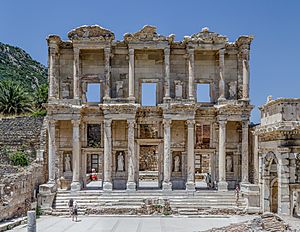
The name Ti-smurna was found on old tablets from the Assyrian colony in Kültepe. This was in the early 2nd millennium BC. We are not sure if this name refers to today's İzmir.
The modern name İzmir comes from the Greek name Smyrna. In the Middle Ages, people in the West used names like Smire or Esmira. These names became İzmir in Turkish.
The İzmir region was part of the Yortan culture in ancient Anatolia. Later, it was part of the Arzawa Kingdom, which was linked to the Hittites. Some people think the city's name might be connected to an Amazon named Smyrna. Others believe it comes from the Myrrha commifera plant, which produces a resin called myrrh. This resin was a main export of the city long ago.
The Romans called the city Smyrna. This name was used in English until the 20th century. After Turkey started using the Latin alphabet in 1928, the name Izmir became widely used. However, some languages like Italian and Spanish still use forms of Smyrna.
A Look at İzmir's Past
Early Settlements and Ancient Times
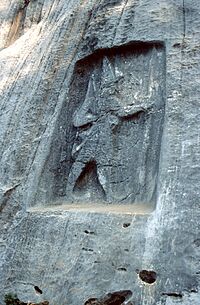
İzmir is one of the oldest places where people have lived in the Mediterranean Sea area. In 2004, archaeologists found Yeşilova Höyük and Yassıtepe. These discoveries showed that the city's history goes back even further than thought. Findings from these sites show settlements from the early to mid-Chalcolithic and Neolithic periods. This means people lived here between 7000 BC and 4000 BC.
The first settlement to control the Gulf of İzmir was on Mount Yamanlar. Later, "Old Smyrna" was built on a hill in what is now the Tepekule neighborhood in Bayraklı. This settlement might date back to 3000 BC. Finds from the late Bronze Age show some influence from Mycenaean Greece.
Old Smyrna: A Growing City
The ancient writer Pausanias mentioned a port named after Tantalus in İzmir's area. The term "Old Smyrna" refers to the city during the Archaic Period at Tepekule, Bayraklı. This is different from the city rebuilt later on Mount Pagos (now Kadifekale). Greek settlements in Old Smyrna are shown by pottery from around 1000 BC. The oldest ruins are from 725–700 BC.
According to Herodotus, Aeolians founded the city, and later Ionians took it over. The oldest house found in Bayraklı is from 925 to 900 BC. It was a small room made of sun-dried bricks and reeds. Another house from the 7th century BC had two floors and five rooms. Around this time, people built strong walls around the city. Smyrna was planned with straight streets that crossed at right angles. This was an early example of city planning in the West.
Homer, a famous ancient poet, is said to have been born in Smyrna in the 7th or 8th century BC. Many believe he was born in Ionia. The River Meles, still in the city, is linked to Homer's stories.
From the 7th century onwards, Smyrna became a city-state. About a thousand people lived inside the city walls. Others lived in nearby villages, working in farming and fishing. The most important temple was the Temple of Athena, built around 640–580 BC. Smyrna became an important trading center in the Mediterranean. It was one of the twelve Ionian cities and reached its peak between 650–545 BC.
Lydian and Persian Rule
The Lydians conquered Smyrna around 610–600 BC. They burned parts of the city, but the temple was quickly repaired. Soon after, the Persian Empire invaded Anatolia. The Persian emperor Cyrus the Great destroyed Old Smyrna in 545 BC. This ended its time as a major city.
Alexander the Great's Influence
Alexander the Great rebuilt the city in a new spot around 340 BC. Old Smyrna was too small for many people. So, the new city was built on the slopes of Mount Pagos (Kadifekale). This helped the city's population grow again.
Roman Era Prosperity

In 133 BC, Smyrna became part of the Roman Republic. The city became very successful during Roman rule. By the end of the 1st century AD, Smyrna was one of the seven churches of Asia mentioned in the Bible. Apostle John encouraged Christians there to stay strong in their faith.
Important Roman emperors like Hadrian and Caracalla visited Smyrna. In 178 AD, a big earthquake damaged the city. Emperor Marcus Aurelius helped a lot to rebuild it. The agora (a public meeting place) was restored. Many old buildings in İzmir today are from this Roman period.
After the Roman Empire split, Smyrna became part of the Eastern Roman Empire (Byzantine Empire). It remained an important religious center but did not reach its earlier Roman wealth.
Medieval Times
Turkic peoples first took Smyrna in 1076 under the Seljuk commander Çaka Bey. He used İzmir as a base for his ships. In 1097, the Byzantines took the city back. Later, the Knights of St John captured it in 1204 during the Fourth Crusade. But the Nicaean Empire soon got it back.
In the 14th century, Umur Bey, a Turkish leader, captured Smyrna again. Like Çaka Bey, he used the city for naval raids. In 1344, a group of forces led by Pope Clement VI took back the lower castle. For 60 years, the Turkish leaders held the upper castle, and the Knights held the lower one.
Ottoman Period
The Ottomans first captured İzmir's upper city in 1389. But in 1402, Timur defeated the Ottomans. He attacked and destroyed Smyrna, causing many Christians to lose their lives. In 1415, Mehmet I took İzmir back for the Ottomans. By 1426, the city was fully under Ottoman control.
In the 15th century, Sephardic Jews arrived from Spain after 1492. They made İzmir one of their main cities in the Ottoman lands. İzmir was not very populated in the 15th and 16th centuries. By 1576, it had grown to about 3,500 to 5,000 people.
A Busy International Port
İzmir started to grow a lot in the late 16th century. Cotton and other goods attracted traders from France, England, and the Netherlands. By the 17th century, İzmir became a major international port. Foreign countries set up consulates (offices for their representatives) in the city. Each consulate had its own dock for ships.
Despite a plague in 1676, an earthquake in 1688, and a big fire in 1743, the city kept growing. By the end of the 17th century, İzmir had about 90,000 people. Most were Turks, but there were also many Greeks, Armenians, and Jews.
In 1770, the Ottoman fleet was destroyed near İzmir. This led to violence against local Greeks. In 1797, a riot caused damage and more loss of life. In 1818, a traveler noted that İzmir had about 60,000 Turks, 40,000 Greeks, 10,000 Jews, and other groups.
The first railway lines in Turkey started from İzmir. A railway to Aydın began in 1856. Another line, the Smyrna-Cassaba Railway, started in 1863. These railways helped the city grow, especially the northern areas. By 1867, İzmir became the center of its own province.
In the late 19th century, the port faced problems with silt (mud) buildup. So, the Gediz River was redirected in 1886 so it would no longer flow into the gulf. By the early 20th century, İzmir looked like a global city with many different cultures. Before World War I, İzmir had more Greeks than Athens, the capital of Greece.
Modern Times
After the Ottoman Empire lost World War I, some countries planned to divide parts of Anatolia. Western Turkey was offered to Greece. On May 15, 1919, the Greek Army landed in Smyrna. However, the Greek advance into central Anatolia did not go well. By September 1922, the Greek army was defeated.
The Turkish Army took back the city on September 9, 1922. This ended the Greco-Turkish War (1919–1922). Four days later, on September 13, 1922, a huge fire started in the city. It lasted until September 22. The fire destroyed the Greek and Armenian parts of the city. The Muslim and Jewish areas were not damaged. Many people lost their lives, and hundreds of thousands of Greek and Armenian refugees crowded the waterfront. They waited for ships to escape. The evacuation of Greeks began on September 24. About 150,000 to 200,000 Greeks were evacuated. The remaining Greeks left for Greece in 1923 as part of a population exchange between Greece and Turkey. This was agreed upon in the Treaty of Lausanne.
The war and the fire greatly affected both Turkey and Greece. The city was slowly rebuilt after the Turkish Republic was formed in 1923.
In 2020, an earthquake and tsunami damaged the city. It was the deadliest earthquake that year. 117 people died in Turkey, almost all of them in İzmir.
Today, İzmir is made up of several metropolitan districts. The Konak district is the historical center. In 2013, all thirty districts of İzmir Province became part of İzmir's metropolitan area.
People of İzmir
| Year | Population | Year | Population | ||
|---|---|---|---|---|---|
| 1595 | 2,000 | 1955 | 286,000 | ||
| 1640 | 35,000–40,000 | 1660 | 60,000–70,000 | 1960 | 371,000 |
| 1890 | 200,000 | 1965 | 442,000 | ||
| 1918 | 300,000 | 1970 | 554,000 | ||
| 1927 | 154,000 | 1985 | 1,489,817 | ||
| 1935 | 171,000 | 1990 | 1,758,780 | ||
| 1940 | 184,000 | 2000 | 2,232,265 | ||
| 1945 | 200,000 | 2007 | 2,606,294 | ||
| 1950 | 231,000 | 2009 | 2,727,968 | ||
| 2014 | 2,847,691 |
After the 1960s, İzmir grew very quickly. Many people moved to the city from other parts of Anatolia. This caused a big population increase. Today, İzmir is still growing in different directions. New housing projects and industrial areas are being built.
Most of İzmir's population is Muslim. However, until the early 20th century, most people were not Muslim. İzmir has Turkey's second largest Jewish community, with about 2,500 people. They mostly live in the Karataş area. Famous Jewish figures from İzmir include Sabbatai Zevi and Darío Moreno.
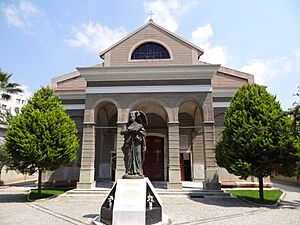
The Catholic Levantines of İzmir are mostly from Italy and France. They live mainly in Bornova and Buca. İzmir also has people of African descent, known as Afro-Turks. They are descendants of people who came to the Ottoman Empire.
İzmir used to have many Greeks and Armenians. But after the 1922 fire and the end of the Greco-Turkish War, many left or were forced to move to Greece.
Weather in İzmir
İzmir has a hot-summer Mediterranean climate. This means it has long, very hot, and dry summers. Winters are cool and rainy. İzmir gets a good amount of rain each year. Most of it falls from November to March. There is usually very little rain from June to September, and summer droughts are common.
The highest daily rainfall was 145.3 mm on September 29, 2006. The strongest wind was 127.1 km/h on March 29, 1970.
In winter, temperatures are usually between 10 and 16 degrees Celsius (50-61 Fahrenheit). Snow is rare but can fall from December to February. It usually melts in a few hours. Frost can happen at night in winter. In summer, temperatures can reach 40 degrees Celsius (104 Fahrenheit). But they are usually between 30 and 36 degrees Celsius (86-97 Fahrenheit).
The Etesian winds, also called meltem, blow regularly in the Gulf of İzmir.
| Climate data for İzmir (1991–2020, extremes 1938–2023) | |||||||||||||
|---|---|---|---|---|---|---|---|---|---|---|---|---|---|
| Month | Jan | Feb | Mar | Apr | May | Jun | Jul | Aug | Sep | Oct | Nov | Dec | Year |
| Record high °C (°F) | 22.5 (72.5) |
27.0 (80.6) |
30.5 (86.9) |
32.5 (90.5) |
37.6 (99.7) |
41.3 (106.3) |
43.2 (109.8) |
43.0 (109.4) |
40.1 (104.2) |
36.0 (96.8) |
30.3 (86.5) |
25.2 (77.4) |
43.2 (109.8) |
| Mean daily maximum °C (°F) | 12.7 (54.9) |
14.0 (57.2) |
17.2 (63.0) |
21.3 (70.3) |
26.5 (79.7) |
31.3 (88.3) |
33.8 (92.8) |
33.6 (92.5) |
29.5 (85.1) |
24.6 (76.3) |
18.8 (65.8) |
14.0 (57.2) |
23.1 (73.6) |
| Daily mean °C (°F) | 9.0 (48.2) |
9.9 (49.8) |
12.4 (54.3) |
16.2 (61.2) |
21.1 (70.0) |
26.0 (78.8) |
28.6 (83.5) |
28.5 (83.3) |
24.2 (75.6) |
19.5 (67.1) |
14.4 (57.9) |
10.5 (50.9) |
18.4 (65.1) |
| Mean daily minimum °C (°F) | 6.0 (42.8) |
6.6 (43.9) |
8.6 (47.5) |
11.8 (53.2) |
16.2 (61.2) |
20.9 (69.6) |
23.5 (74.3) |
23.7 (74.7) |
19.5 (67.1) |
15.4 (59.7) |
10.9 (51.6) |
7.7 (45.9) |
14.2 (57.6) |
| Record low °C (°F) | −8.2 (17.2) |
−5.2 (22.6) |
−3.8 (25.2) |
0.6 (33.1) |
4.3 (39.7) |
9.5 (49.1) |
15.4 (59.7) |
11.5 (52.7) |
10.0 (50.0) |
3.6 (38.5) |
−2.9 (26.8) |
−4.7 (23.5) |
−8.2 (17.2) |
| Average precipitation mm (inches) | 127.5 (5.02) |
107.2 (4.22) |
77.8 (3.06) |
50.1 (1.97) |
32.9 (1.30) |
14.4 (0.57) |
3.0 (0.12) |
6.7 (0.26) |
23.5 (0.93) |
56.5 (2.22) |
99.6 (3.92) |
131.3 (5.17) |
730.5 (28.76) |
| Average precipitation days | 11.57 | 12.00 | 10.23 | 9.00 | 7.10 | 3.67 | 0.67 | 0.83 | 3.07 | 6.67 | 9.07 | 13.30 | 87.2 |
| Average snowy days | 0.53 | 0.56 | 0.13 | 0 | 0 | 0 | 0 | 0 | 0 | 0 | 0 | 0.19 | 1.41 |
| Average relative humidity (%) | 68.9 | 67.3 | 63.5 | 60.3 | 57.6 | 51.6 | 48.7 | 50.7 | 56.0 | 63.1 | 67.4 | 70.1 | 60.4 |
| Mean monthly sunshine hours | 139.5 | 146.9 | 204.6 | 237.0 | 300.7 | 345.0 | 381.3 | 359.6 | 291.0 | 235.6 | 174.0 | 130.2 | 2,945.4 |
| Mean daily sunshine hours | 4.5 | 5.2 | 6.6 | 7.9 | 9.7 | 11.5 | 12.3 | 11.6 | 9.7 | 7.6 | 5.8 | 4.2 | 8.0 |
| Source 1: Turkish State Meteorological Service | |||||||||||||
| Source 2: NOAA (humidity, 1991-2020), Meteomanz(snow days 2008-2023) | |||||||||||||
Fun Places to See in İzmir
- The tomb of Tantalus on Mount Yamanlar was found in 1835. It shows how old the region's history is.
- The Agora of Smyrna is a well-preserved ancient market. It is now the Agora Open Air Museum of İzmir.
- The ancient theater of Smyrna, where St. Polycarp was martyred, is under a modern urban area.
- On top of Kadifekale hill, there is an ancient castle, which is a famous landmark.
- The Kızılçullu aqueducts in Buca district are also ancient structures.
- The Clock Tower is a marble tower in the Konak district. It is 25 meters (82 feet) tall and was built in 1901. It has four fountains at its base.
- The Kemeraltı bazaar is a lively market area built by the Ottomans. It is near the Agora and Kadifekale.
- İzmir had three historical castles: Kadifekale, Ok Kalesi (the port castle), and Sancakkale. Sancakkale is important because it guarded the narrow entrance to the Gulf of İzmir.
- There are nine synagogues in İzmir. They are in the traditional Jewish quarter of Karatas or on Havra Sokak (Synagogue street) in Kemeraltı.
- The Atatürk Mask is a huge concrete relief of Mustafa Kemal Atatürk. He was the founder of modern Turkey. It is located south of Kadifekale.
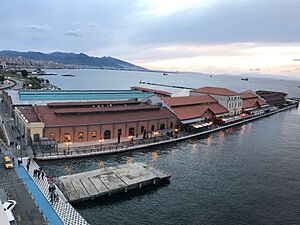
- The İzmir Bird Paradise (İzmir Kuş Cenneti) in Çiğli is a bird sanctuary. It has 205 types of birds. A large open-air zoo, Sasalı Park of Natural Life, was also opened in Çiğli in 2008.
Culture and Fun in İzmir
İzmir International Fair
İzmir is known for its many trade fairs, exhibitions, and conferences. The main fair is held in Kültürpark, a large city park, in early September.
Festivals
The International İzmir Festival happens every year from mid-June to mid-July. It has been running since 1987. Many famous performers, orchestras, and dance groups perform at different places. These include ancient theaters like Ephesus and Metropolis. The festival is part of the European Festivals Association.
The İzmir European Jazz Festival is another popular event. It has been held every year since 1994. It brings together jazz musicians and fans.
The International İzmir Short Film Festival started in 1999. It is also part of the European Coordination of Film Festivals.
The İzmir Metropolitan Municipality built the Ahmet Adnan Saygun Art Center. It is a big center for culture and art in the city.
Music
In 2015, the Barış Youth Symphony Orchestra was started. It helps children from low-income areas learn music. The orchestra has grown to almost 100 members. They perform with famous classical music artists.
Food in İzmir
İzmir's food is a mix of different cultures from its history. It has many dishes from the Aegean and Mediterranean areas. People moving from other parts of Turkey have also added to the local food. The fertile land around İzmir grows many vegetables. Green leafy vegetables and wild plants are often used, especially by people from Crete.
Some common dishes include:
- tarhana soup (made from dried yoghurt and tomatoes).
- "İzmir" köfte (meatballs).
- keşkek (boiled wheat with meat).
- zerde (sweet rice with saffron).
- mücver (made from zucchini and eggs).
boyoz and lokma are pastries linked to İzmir. They were brought by Sephardic people. Kumru is a special sandwich from the Çeşme district. It usually has cheese, tomato, and sometimes sucuk (a type of sausage).
İzmir's Economy

The port of İzmir is Turkey's main port for exports. Its free zone is the biggest among Turkey's twenty zones. Many young professionals work in İzmir or nearby cities like Manisa. Companies in İzmir are becoming more important globally.
Trade through İzmir's port was very important for the Ottoman Empire. It also helped build Turkey's economy in its early years.
Today, İzmir's economy is divided into different areas:
- 30.5% is from industry.
- 22.9% is from trade and related services.
- 13.5% is from transportation and communication.
- 7.8% is from agriculture.
In 2008, İzmir provided 10.5% of all tax money collected by Turkey. Its exports were 6% of Turkey's total, and its imports were 4%. İzmir Province is Turkey's third largest exporter. Most of the region's exports go through the Port of Alsancak.
Sports in İzmir
İzmir has hosted many important international sports events:
- 2013 – 2012–13 FIBA EuroChallenge Final Four (basketball).
- 2011 – 2011 European Team Championships First League (track and field).
- 2010 – Group D of the 2010 FIBA World Championship (basketball).
- 2009 – 2009 Men's European Volleyball Championship.
- 2008 – The 7th WTF World Junior Taekwondo Championship.
- 2006 – The 2006 European Seniors Fencing Championship.
- 2006 – The U20 European Basketball Championship for Men.
- 2005 – The 2005 Summer Universiade (International University Sports Games).
- 2005 – Preliminary games of the 2005 European Women's Basketball Championship.
- 1971 – The 1971 Mediterranean Games.
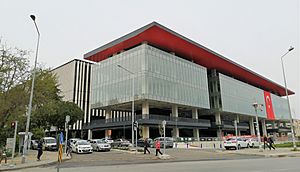
The İzmir Atatürk Stadium is very large and hosts many football games. İzmir has three big football clubs: Altay, Göztepe, and Karşıyaka.
Göztepe made history by reaching the semi-finals of the Inter-Cities Fairs Cup in 1968–69. They were the first Turkish football club to do this in Europe.
Karşıyaka's basketball team, Karşıyaka Basket, has won the Turkish Basketball League twice. They play at the Karşıyaka Arena. The Halkapınar Sports Hall is İzmir's largest indoor sports arena.
Arkas Spor is a successful volleyball club in İzmir. They have won the Turkish Men's Volleyball League many times.
İzmir has many sports legends. Onomastus won a boxing contest in the ancient Olympics in 688 BC. Metin Oktay, a famous football star from the 1960s, was born in İzmir. He was the first Turkish footballer to play in Italy.
The İzmir Metropolitan Municipality (İBB) Sports Club's ice hockey team started playing in the Turkish Ice Hockey Super League in 2011–2012.
Media in İzmir
İzmir has its own local media. There are 9 TV channels based in İzmir that broadcast in the Aegean Region. There are also 26 local radio stations and 15 local newspapers. TRT Belgesel (TRT Documentary) is a national TV channel that broadcasts from İzmir.
TV Channels
- Ege TV (Local TV)
- Kanal 35 (Local TV)
- Sky TV (Local TV)
- Kordon TV (Local TV)
- FRM TV (Online TV)
- Ege Üniversitesi TV (Local TV)
- Ben TV (Online TV) Ben TV - Ege ve İzmir Haberleri, Güncel Haberler
- Yenigün TV (Online TV)
- TRT Belgesel (National TV)
Local Radio Stations
- Radyo İzmir
- Romantik Radyo
- Romantik Türk
- Radyo 35
- Kordon FM
- İmbat FM
- Radyo Kordelya
- Radyo Efe
- Oynak FM
- Duygusal FM
- Sky Radyo
- Radyo Pause
- Radyo Ege
- Ege FM
- Ege'nin Sesi Radyosu
- Herkül FM
- Can Radyo
- Batı Radyo
- Radyo Gökkuşağı
- Yıldız FM
- Buca FM
- Radyo Ege Kampüs 100.8
- Rock City FM
- öRT FM
- Y.Tire FM
- DEÜ FM
Newspapers and Magazines
- Ege Telgraf [1]
- Ekonomik Çözüm
- Gözlem
- Haber Ekspres
- Ticaret
- Gazete Yenigün [2]
- Yeni Asır
- Yeni Ekonomi
- Yenigün Gazetesi
- 9 Eylül Gazetesi [3]
- Küçük Menderes Gazetesi
- Büyük Tire
- Ege Gazetesi Tüm adresleri tek adreste
İzmir in Books and Art
Many books and artworks feature İzmir:
- The play L'impresario delle Smirne by Carlo Goldoni (1759).
- The poem "The Turkish Captive" in Les Orientales by Victor Hugo (1828).
- The piano piece "In Smyrna" by Edward Elgar (1905).
- The novel Mask of Dimitrios by Eric Ambler (1939).
- The film You Can't Win 'Em All (1970).
- The novel Farewell Anatolia by Dido Sotiriou (1962).
- The novel Middlesex by Jeffrey Eugenides (2002).
- The novel Birds Without Wings by Louis de Bernières (2005).
Learning in İzmir
İzmir has nine universities. It also has old and famous schools like the İzmir Anatolian Vocational High School of Commerce (since 1854) and the American Collegiate Institute (since 1878).
In the past, İzmir was a big learning center for Greeks. The Evangelical School of Smyrna was an important Greek school from 1733 to 1922.
İzmir is also home to Space Camp Turkey, one of only three U.S. Space Camps in the world.
Universities in İzmir
- Ionian University – The first university in the city, planned in 1920.
- Ege University – Started in 1955.
- Dokuz Eylül University – Started in 1982.
- İzmir University of Economics – A private university started in 2002. Its campus is in Balçova.
- Yaşar University – Started in 2001. Its main campus is in Bornova.
- İzmir Kâtip Çelebi University – Started in 2010.
- İzmir Democracy University – Started in 2016.
- İzmir Tınaztepe University – Started in 2018.
Universities Near İzmir
- İzmir Institute of Technology – Started in 1992. Its campus is in Urla.
- İzmir Bakırçay University – Started in 2016.
- Sağlık Bilimleri Üniversitesi – Started in 2015.
International Schools
- Deutsche Schule Izmir (German school)
- Scuola Primaria e dell'Infanzia Italiana di Smirne (Italian school)
Getting Around İzmir
İzmir has an airport for flights within Turkey and to other countries. It also has modern public transport systems. The city's good location and new transport systems attract businesses.
Travel Between Cities
By Air
The Adnan Menderes International Airport (ADB) connects İzmir to many places. It is in the Gaziemir district.
By Bus
The main bus station, the Otogar, is in the Pınarbaşı area. Buses go to cities all over Turkey. Bus companies offer free shuttle services from their offices around the city.
By Train
İzmir has two old train stations in the city center: Alsancak Terminal (built 1858) and Basmane Terminal (built 1866). The Turkish State Railways runs regional trains to nearby towns. They also have longer trains to cities like Ankara.
Getting Around the City
İzmir has a good public transport system since 1999. You can use an electronic card called İzmirim Kart (My İzmir Card). This card works on all metro lines, buses, ferries, and trams. You can use different types of transport within 120 minutes for one price.
Buses
İzmir's main districts have a wide bus network called ESHOT. ESHOT runs 322 bus lines with about 1,500 buses. Another company, İzulaş, also runs buses for ESHOT. There are also private minibus services called dolmuş.
Ferries
İzmir's city ferries are run by the Metropolitan Municipality. 24 ferries travel between 9 different docks. These services are cheap, and many people enjoy a ferry ride for fun.
Metro
İzmir has a metro system that is always growing. The İzmir Metro has one main line. It goes from Narlıdere in the west to Bornova in the northeast. The line is 27 kilometers (17 miles) long.
Regional Trains
İZBAN is a commuter rail system that connects İzmir's city and suburban areas. It is Turkey's busiest commuter railway, carrying about 150,000 passengers daily. İZBAN means "İzmir" and "Banliyö" (suburb).
İZBAN started in 2010. It has a 136-kilometer (85-mile) system with 40 stations and two lines. İZBAN is owned by the Turkish State Railways and the İzmir Metropolitan Municipality.
Tram
İzmir's tram system is owned by the city. It has three separate lines: one in Karşıyaka (opened 2017), one in Konak (opened 2018), and one in Çiğli (opened 2024).
Public Transport Facts
On average, people in İzmir spend 62 minutes traveling on public transport on a weekday. 13% of riders travel for more than 2 hours each day. People wait about 15 minutes at a stop, and 27% wait for over 20 minutes. The average distance for one trip is 10.4 km (6.5 miles).
Famous People from İzmir
Sister Cities
İzmir has many sister cities around the world. These are cities that have special friendly relationships.
Europe
|
Asia
Africa |
Americas
|
See also
 In Spanish: Esmirna para niños
In Spanish: Esmirna para niños




